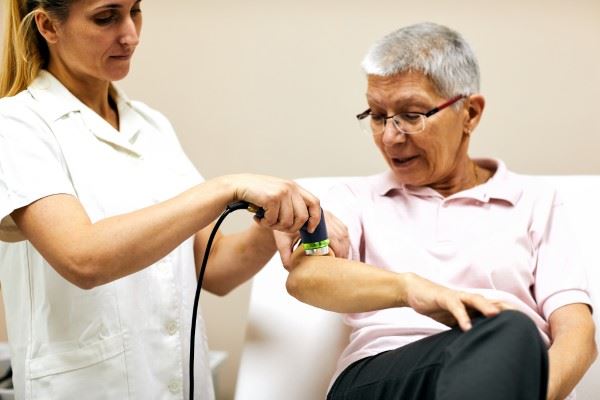-
Home
-
Electrical Modalities Used in Physical Therapy
Electrical Modalities Used in Physical Therapy
September 7, 2023

There are several modalities that physical therapists use to help reduce pain and inflammation, improve circulation, and promote healing for damaged tissue. These modalities include the use of electrical stimulation, heat therapy, cold therapy, and massage. This article will focus on understanding the use and benefits of electrical modalities in physical therapy.
What Are Electrical Modalities Used For?
Also known as electrotherapy, electrical modalities in physical therapy involve the use of electrical impulses to stimulate nerves and muscles, reduce the formation of scar tissue, and promote tissue healing. Modalities such as ultrasound can be used to break down scar tissue and improve flexibility, while other types of electrical stimulation can help reduce pain and improve circulation in the affected area.
Types of Electrical Modalities
All types of electrical modalities use electrical currents to treat a variety of conditions, including pain, inflammation, and muscle weakness. These types include neuromuscular electrical stimulation, transcutaneous electrical nerve stimulation, ionophoresis, and ultrasound—each of which has its own unique benefits and applications.
Neuromuscular Electrical Stimulation (NMES)
One of the most common types is neuromuscular electrical stimulation (NMES), which involves electrodes placed on the skin surface to stimulate nerves and muscles. NMES works by using a muscle stimulator to send controlled electrical impulses through electrodes placed on the skin near the targeted muscle group. These electrical impulses mimic the signals that the central nervous system normally sends to muscles to initiate contractions.
NMES is often used to reduce pain and swelling, decrease muscle spasms, and improve circulation to affected areas. This type of therapy is often used for patients who are recovering from a stroke or injury.
Transcutaneous Electrical Nerve Stimulation (TENS)
Another common form of electrical modality is transcutaneous electrical nerve stimulation (TENS), which provides a low-level electrical current to the nerves beneath the skin. To administer this therapy, adhesive electrodes are placed on the skin near the area of pain or discomfort. The electrodes are connected to a TENS unit, which generates electrical impulses. The placement of electrodes is important to target the specific nerves associated with the painful area.
TENS units are often used to help reduce pain and improve circulation to an affected area. This is helpful for those who suffer from chronic conditions, such as arthritis, fibromyalgia, or back pain. TENS units can also be effective in the treatment of more acute pain due to injury or surgery.
Iontophoresis
Ionophoresis is another electrical modality used in physical therapy to reduce pain and inflammation. It uses a small electrical current to deliver medication through the skin and into the underlying tissues, helping treat various musculoskeletal and inflammatory conditions such as tendonitis, bursitis, and localized muscle pain.
Ionophoresis typically requires a specialized machine with two electrodes—one connected to a medication-soaked pad, which is placed on the skin at the treatment site, and another placed elsewhere on the body to complete the circuit. The machine applies a small electrical current, causing the charged medication ions to move through the skin toward the targeted tissues.
Ultrasound
Ultrasound, which uses high-frequency sound waves to penetrate deep tissue and reduce pain and swelling, is another common form of electrotherapy. The heat generated by ultrasound also increases blood flow and stimulates metabolic activity, helping accelerate tissue repair, reduce inflammation, and promote tissue regeneration. The mechanical vibrations induced by ultrasound can cause deep tissues to relax, which is useful for reducing muscle spasms, tension, and stiffness.
The combination of increased blood flow, tissue relaxation, and stimulation of metabolic activity can help alleviate both chronic and acute pain. Ultrasound can be used to treat everything from scar tissue to trigger points and is often used in conjunction with other techniques like cold packs or heat therapy.
Overall, electrical modalities are an important part of physical therapy, and they can be highly effective for reducing pain, improving movement function, and increasing circulation in affected areas. If you're considering physical therapy for a chronic condition or an injury, it's important to ask your therapist about the different modalities they use and how they can help you achieve your recovery goals.